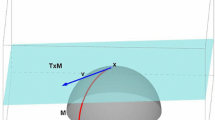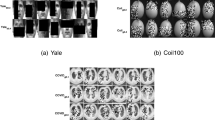Abstract
Fisher’s Linear Discriminant Analysis (LDA) has been recognized as a powerful technique for face recognition. However, it could be stranded in the non-Gaussian case. Nonparametric discriminant analysis (NDA) is a typical algorithm that extends LDA from Gaussian case to non-Gaussian case. However, NDA suffers from outliers and unbalance problems, which cause a biased estimation of the extra-class scatter information. To address these two problems, we propose a robust large margin discriminant tangent analysis method. A tangent subspace-based algorithm is first proposed to learn a subspace from a set of intra-class and extra-class samples which are distributed in a balanced way on the local manifold patch near each sample point, so that samples from the same class are clustered as close as possible and samples from different classes will be separated far away from the tangent center. Then each subspace is aligned to a global coordinate by tangent alignment. Finally, an outlier detection technique is further proposed to learn a more accurate decision boundary. Extensive experiments on challenging face recognition data set demonstrate the effectiveness and efficiency of the proposed method for face recognition. Compared to other nonparametric methods, the proposed one is more robust to outliers.




Similar content being viewed by others
Notes
Open set domains assume that new classes may be encountered. In contrast, closed set domains assume that all classes of a domain have been known and can be used in training.
References
Belhumeur P, Hespanha J, Kriegman D (1997) Eigenfaces vs. fisherfaces: recognition using class specific linear projection. IEEE Trans Pattern Anal Mach Intell 19(1):711–720
Fransens R, Prins J, Gool L (2003) Svm-based nonparametric discriminant analysis, an application to face detection. In: IEEE international conference on computer vision
Fukunaga K (1990) Statistical pattern recognition. Academic Press, San Diego
Georghiades A, Belhumeur P, Kriegman D (2001) From few to many: illumination cone models for face recognition under variable lighting and pose. IEEE Trans Pattern Anal Mach Intell 23(6):643–660
He R, Ao M, Xiang S, Li SZ (2008) Nearest feature line: a tangent approximation. In: Chinese conference on pattern recognition
He R, Hu BG, Zheng WS, Kong XW (2011a) Robust principal component analysis based on maximum correntropy criterion. IEEE Trans Image Process (preprint)
He R, Zheng WS, Hu BG (2011b) Maximum correntropy criterion for robust face recognition. IEEE Trans Pattern Anal Mach Intell (preprint)
He R, Zheng WS, Hu BG, Kong XW (2011c) A regularized correntropy framework for robust pattern recognition. Neural Comput (preprint)
Huang Y, Liu Q, Metaxas D (2007) A component based deformable model for generalized face alignment. In: International conference on computer vision, pp 1–8
Lee C, Landgrebe D (1993) Feature extraction based on decision boundaries. IEEE Trans Pattern Anal Mach Intell 15(4):388–400
Lee J, Wang J, Zhang C, Bian Z (2004) Probabilistic tangent subspace: a unified view. In: IEEE conference on computer vision and pattern recognition
Li JB, Pan JS, Lu ZM (2009) Face recognition using gabor-based complete kernel fisher discriminant analysis with fractional power polynomial models. Neural Comput Appl 18(6):613–621
Li JB, Pan JS, Lu ZM (2009) Kernel optimization-based discriminant analysis for face recognition. Neural Comput Appl 18(6):603–612
Li X, Tao D (2010) Subspace learning. Neurocomputing 73(10-12):1539–1540
Li Y, Ito W (2005) Shape parameter optimization for adaboosted active shape model. In: International conference on computer vision, pp 251–258
Liu C, Wechsler H (2002) Gabor feature based classification using the enhanced fisher linear discriminant model for face recognition. IEEE Trans Image Process 11(4):467–476
Nie F, Xiang S, Song Y, Zhang C (2007a) Optimal dimensionality discriminant analysis and its application to image recognition. In: IEEE conference on computer vision and pattern recognition
Nie F, Xiang S, Zhang C (2007b) Neighborhood minmax projections. In: International joint conference on artificial intelligence, pp 993–998
Pang Y, Yuan Y, Li X (2007) Generalized nearest feature line for subspace learning. IEE Electron Lett 43(20):1079–1080
Pang Y, Yuan Y, Li X (2009) Iterative subspace analysis based on feature line distance. IEEE Trans Image Process 18:903–907
Philips P, Flynn P, Sruggs T, Bowyer K (2005) Overview of the face recognition grand challenge. In: Computer vision and pattern recognition
Phillips PJ, Moon H, Rizvi SA, Rauss PJ (2000) The feret evaluation methodology for face-recognition algorithms. IEEE Trans Pattern Anal Mach Intell 22(10):1090–1104
Qiu X, Wu L (2005) Face recognition by stepwise nonparametric margin maximum criterion. In: IEEE international conference on computer vision
Sim T, Baker S, Bsat M (2005) The cmu pose, illumination, and expression database. IEEE Trans Pattern Anal Mach Intell 25:1615–1618
Simard P, LeCun Y, Denker J, Victorri B (2001) Transformation invariance in pattern recognition-tangent distance and tangent propagation. Int J Imaging Syst Technol 11:181–194
Song D, Tao D (2009) Discrminative geometry preserving projections. In: Proceedings of the international conference on image processing, pp 2457–2460
Tao D, Li X, Wu X, Maybank SJ (2009) Geometric mean for subspace selection. IEEE Trans Pattern Anal Mach Intell 31(2):260–274
Zhou T, Tao D, Wu X (2010) Manifold elastic net: A unified framework for sparse dimension reduction. Data Min Knowl Discov 22(3):340–371
Wang X, Tang X (2004) A unified framework for subspace face recognition. IEEE Trans Pattern Anal Mach Intell 26(9):1222–1228
Wright J, Yang A, Ganesh A, Sastry S, Ma Y (2008) Robust face recognition via sparse representation. IEEE Trans Pattern Anal Mach Intell 31(2):210–227
Xiong L, Li J, Zhang C (2007) Discriminant additive tangent spaces for object recognition. In: IEEE conference on computer vision and pattern recognition
Yan S, Xu D, Zhang B, Zhang H, Yang Q, Lin S (2007) Graph embedding and extensions: a general framework for dimensionality reduction. IEEE Trans Pattern Anal Mach Intell 29(1):40–51
Yang L (2008) Alignment of overlapping locally scaled patches for multidimensional scaling and dimensionality reduction. IEEE Trans Pattern Anal Mach Intell 30(3):438–450
Zhang T, Yang J, Zhao D, Ge X (2007) Linear local tangent space alignment and application to face recognition. Neurocomputing 70:1547–1553
Zhang T, Li X, Tao D, Yang J (2008) Local coordinates alignment (lca): a novel manifold learning approach. Int J Pattern Recognit Artif Intell 22(4):667–690
Zhang T, Tao D, Li X, Yang J (2008c) A unifying framework for spectral analysis based dimensionality reduction. In: Proceedings of the international joint conference on neural networks, pp 1670–1677
Zhang T, Tao D, Li X, Yang J (2009) Patch alignment for dimensionality reduction. IEEE Trans Knowl Data Eng 21(9):1299–1313
Zhang T, Huang K, Li X, Yang J, Tao D (2010) Discriminative orthogonal neighborhood-preserving projections for classification. IEEE Trans Syst Man Cybern B 40(1):253–263
Zhao D, Lin Z, Tang X (2007a) Laplacian pca and its applications. In: International conference on computer vision
Zhao D, Lin Z, Xiao R, Tang X (2007b) Linear laplacian discrimination for feature extraction. In: IEEE conference on computer vision and pattern recognition
Acknowledgments
This work was supported in part by Research Foundation for the Doctoral Program of the Ministry of Education of China (Grant No. 20100041120009), 985 Project in Sun Yat-sen University (Grant No. 35000-3181305), and NSF-Guangdong (Grant No. U0835005).
Author information
Authors and Affiliations
Corresponding author
Rights and permissions
About this article
Cite this article
Yang, N., He, R., Zheng, WS. et al. Robust large margin discriminant tangent analysis for face recognition. Neural Comput & Applic 21, 269–279 (2012). https://doi.org/10.1007/s00521-011-0589-3
Received:
Accepted:
Published:
Issue Date:
DOI: https://doi.org/10.1007/s00521-011-0589-3




